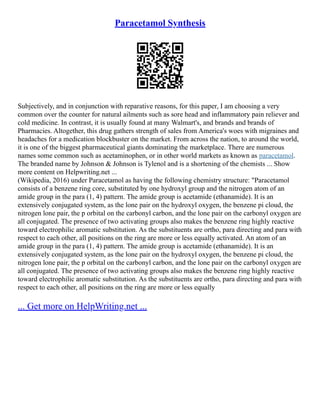The document discusses the iodination of salicylamide through electrophilic aromatic substitution. Salicylamide was reacted with iodine and mercury(II) acetate in glacial acetic acid to form iodo-salicylamide. The iodine substitutes onto the aromatic ring activated by the hydroxyl and amide groups in the ortho or para positions. Recrystallization was used to purify the product, which was then characterized using melting point determination and NMR spectroscopy. The results confirmed the synthesis of iodo-salicylamide through electrophilic aromatic substitution.



























































![The Effect Of Metoprolol On The World Health Organization...
METOPROLOL
Introduction
Metoprolol is a selective β1 receptor blocker.1 It is used to treat high blood pressure or
hypertension, myocardial infarction (MI), heart failure and angina pectoris.2 Metoprolol was first
made in 1969 and is on the World Health Organization's list of essential medicines.3 Metoprolol is
available only in its salt form due to its low melting point, such as metoprolol tartrate or metoprolol
succinate. Its salt form, metoprolol tartrate was first developed by Novartis and was approved by
FDA on August 7, 1978.4 Metoprolol is also available as a generic drug.1
Drug Profile Figure 1. Chemical Structure of Metoprolol
IUPAC Name : 1–(isopropylamino)–3–[4–(2–methoxyethyl)phenoxy] propan–2–ol
Chemical Formula : C15H25NO3
Molecular Weight : 267.364 g/mol
Trade names : Lopressor, Metolar XR, Toprol XL (US)
Nature : Free base exists as a white solid, while its tartrate form exists a fine crystalline material.5
Physical properties* : Solubility – Very soluble (water), Freely soluble (methylene chloride,
chloroform, alcohol), Slightly soluble (acetone) and Insoluble (ether).6 Melting point – 120°C or
248°F.5
*Properties are given, considering the salt form, metoprolol tartrate.
Pregnancy category : C (US). Indicates that it's a risk when used during pregnancy.
Route of administration : Oral and Intravenous (IV)
Pharmacokinetic data : Bioavailability – 50%7 Protein binding – 12% Metabolism – Liver via
CYP2D6, CYP3A4 Half–Life – 3–7 hours
... Get more on HelpWriting.net ...](https://image.slidesharecdn.com/paracetamolsynthesis-231207132503-a7fec49a/85/Paracetamol-Synthesis-60-320.jpg)



































































































